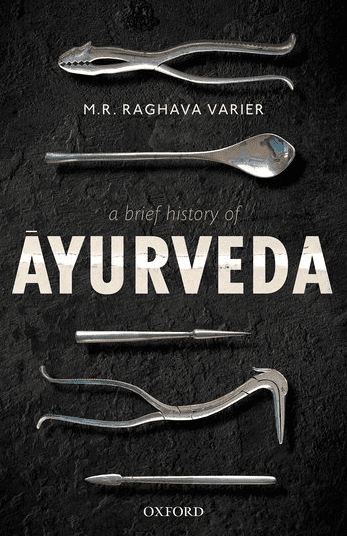Arpan K. Banerjee
Solihull, United Kingdom

Cover of A Brief History of Ayurveda by M.R. Raghava Varier.
Ayurveda translates from the Sanskrit as “the science of life and longevity.” It originated over 4,000 years ago as a system of healing in the Indian subcontinent, where it flourished until the nineteenth century. The Harappan civilization in the Indus valley around 2000 BC saw its early roots in India. The Rig Vedic hymns and texts, also Buddhist and Brahmin texts and archaeological finds, reveal much knowledge of healing, health, and disease. They were followed in the fourth century BC by early Sanskrit works on Ayurveda, described in the Mahabharata as eight components of medicine that included pediatric and general medicine, surgery, otolaryngology, toxicology, and aphrodisiacs.
Ayurvedic practitioners were skilled practitioners and diagnosticians who emphasized the need for a balanced healthy lifestyle. They used plants and herbs to treat diseases in a similar way to the plant-based pharmacological interventions common in European medicine more than a millennium later.
Surgery was surprisingly advanced thanks to the surgical giant of the time, Sushruta (“the Renowned”). He is believed to have taught medicine at Varanasi. His text Sushruta Samhita from the first millennium BC (exact date unknown) contained almost 200 chapters and described over 1,000 diseases. It included surgical descriptions of incisions, ascites, abscess drainage, foreign body extractions, hernia and prostate surgery, cataract and orthopedic surgery, laparotomies and bowel obstruction, and pregnancy. Several surgical instruments were also described. Sushruta has been called the Father of Surgery.
The two important texts for Ayurveda were the Sushruta Samhita and the Caraka Samhita, which actually appeared before Sushruta’s work. Influenced by both the Buddhist religion and Hindu philosophies, these texts were used for centuries to guide the practitioners of this art of healing. The influence of Ayurveda even spread to China.
In India today, even though modern Western medicine is now widely practiced, many patients still prefer the traditional Indian complementary techniques rooted in the Ayurvedic tradition.
This brief scholarly history of Ayurveda is an outstanding introduction to this historical field. The author has produced a readable monograph, extensively referenced with acknowledgments of the scholars who have spent years researching ancient Indian medicine. There is also a list of books and journals for further reading. This book would be profitably read by all those who profess an interest in the history of medicine.
A Brief History of Ayurveda
M.R. Raghava Varier
OUP 2020
Reference
- Banerjee, A. K. “Book review of Ayurvedic Man: encounters with Indian Medicine.” Wellcome Collection, 2017. https://bshm.org.uk/wp-content/uploads/2018/03/Ayurvedic-Man.pdf.
ARPAN K. BANERJEE, MBBS (LOND), FRCP, FRCR, FBIR, qualified in medicine at St. Thomas’s Hospital Medical School, London. He was a consultant radiologist in Birmingham from 1995–2019. He served on the scientific committee of the Royal College of Radiologists 2012–2016. He was Chairman of the British Society for the History of Radiology from 2012–2017. He is Treasurer of ISHRAD and adviser to Radiopaedia. He is the author/co author of numerous papers and articles on a variety of clinical medical, radiological, and medical historical topics and seven books, including Classic Papers in Modern Diagnostic Radiology (2005) and The History of Radiology (OUP 2013).

Leave a Reply